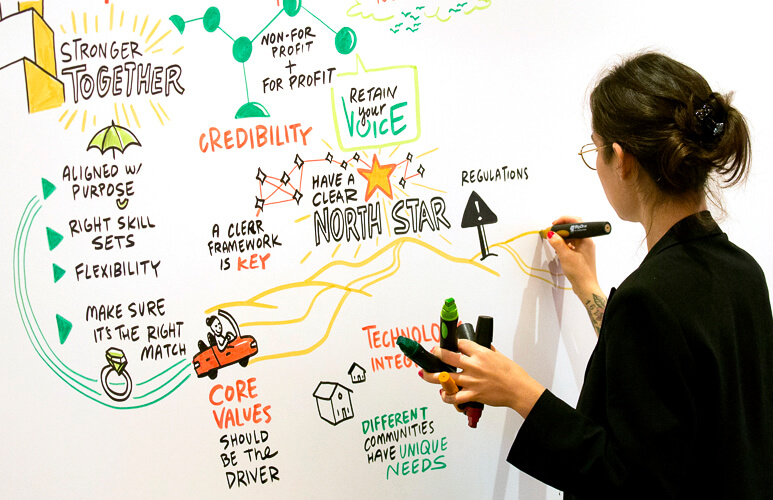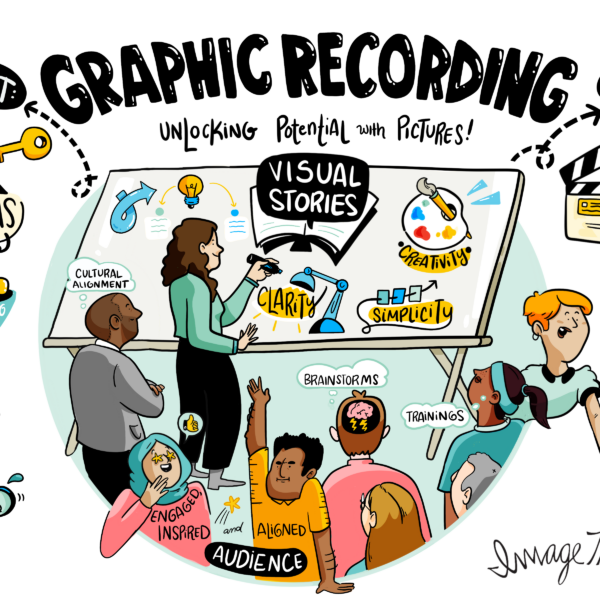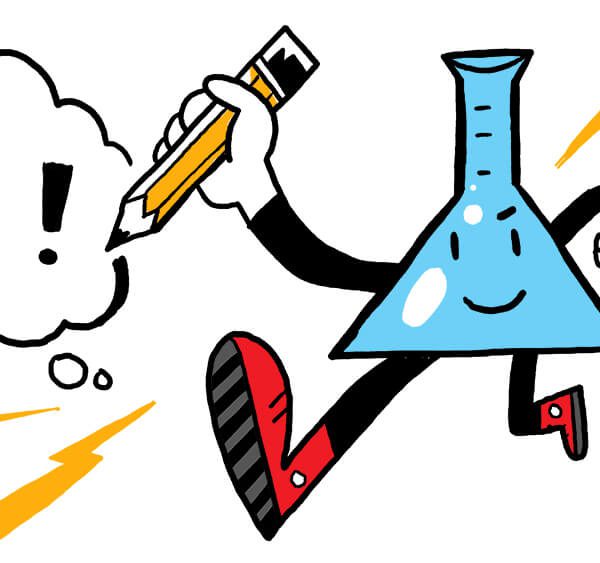This post explores the scientific data behind often-quoted stats around visual thinking, visual learning, and the use of images in learning. You’ll learn what we know about how much what we see impacts what we think.

At ImageThink, we know firsthand the power that visuals have when it comes to boosting cognitive power. Since 2009, we have used graphic facilitation and live illustration to empower strategy sessions, clarify complexity, and spark creative problem solving for Fortune 50 companies the world over.
But don’t take our word for it. In this series of posts, we’re exploring the scientific data behind often-quoted stats regarding visual thinking, visual learning, and the power of images in cognitive development.
A pretty strong case has been made for visuals as learning and teaching tools. Let’s look at the actual makeup of our brain tissues and find out what percentage of the brain is used for vision.
What part of the brain is responsible for vision?
Visual processing happens in the occipital lobe of the brain, which is the above the cerebellum at the back of the skull. The occipital lobe does the heavy lifting, collecting and parsing all of the raw visual data that is taken in by our eyes.
However, the occipital lobe doesn’t work alone to process visuals. The parietal lobe helps with things like recognition, spatial awareness, and navigating our environment. The temporal lobe, which houses memory function, allows us to permanently attach meaning to things we see; for instance, when we see a red octagon with four white letters, our temporal lobe helps us remember that that means we need to hit the breaks and look both ways.
How fast does the brain process visual information?
In John Carpenter’s cult classic Big Trouble in Little China, Kurt Russell’s ineffectual hero Jack Burton states “I never drive faster than I can see, and beyond that it’s all in the reflexes.” But how fast can we actually see, and for that matter process what we see? It takes us approximately half a second (400-500 milliseconds) to respond to visual stimuli; which is really fast.
One MIT study actually found that the brain can process entire images that are seen for as little as13 milliseconds!
That speed is thanks to the nearly 100 billion, with a “B”, neurons we have. And when you consider that nearly half that time – a quarter second – is eaten up by sending the motor signal and giving the response, the time spent receiving the input and deciding on a response is incredibly quick.

True or false? 90% of information transmitted to the brain is visual.
Maybe.
We couldn’t verify this, even though it seems to be all over the web. The only source that mentions this visual thinking fact is a book by Eric Jensen called Brain-Based Learning: The New Science of Teaching & Learning, and we haven’t been able to access the footnotes to see where the citation comes from.
We do know that when our eyes are open, our vision accounts for two-thirds of the electrical activity of the brain – a full 2 billion of the 3 billion firings per second – which was the finding of neuroanatomist R.S. Fixot in a paper published in 1957.
True or False? 40% of all nerve fibers connected to the brain are linked to the retina.
True.
In fact, half of all neural tissue deals with vision in some way.
The nerve fibers statistic is also cited by Eric Jensen in his book on visual learning titled Brain-Based Learning. In that same paper from 1957 that R.S. Fixot published in the American Journal of Ophthalmology, 50% of our neural tissue is directly or indirectly related to vision, which assists in visual learning.

True or False? Almost 50% of our brain is involved in visual processing
True.
University of Rochester researchers found that more than half of the surface of our brains, called the cortex, is dedicated to processing visual stimuli and information. It’s why when we work with some of the largest and most ambitious companies in the world, we encourage what we call “whole brain thinking,” which of course means working visually.
Think of it this way, if you were trying to make the playoffs, would you bench half your team? If you’re working without leveraging visuals and imagery, that’s effectively what you’re doing.
True or False? More of our neurons are dedicated to vision than the other four senses combined.
True.
In fact, we may be out-evolving our sense of smell.
According to John Medina in his book Brain Rules, in the fight for more neural real estate that’s going on between our olfactory cortex and the visual cortex, vision is winning. He writes: “about 60 percent of our smell-related genes have been permanently damaged in this neural arbitrage, and they are marching toward obsolescence at a rate fourfold faster than any other species sampled.” Why? “In the crowded, zero-sum world of the sub-scalp,” Medina said, “something has to give.” So smell those rosebuds while ye may.
Check out our post on the Science of Live Scribing to learn more visual thinking factoids.
True or False? You’re ready to start working visually
Want to learn more ways graphic facilitation can unleash innovative thinking at your next big meeting? Get in touch with ImageThink today for custom quotes on meeting support, team training, and more. We also share 100-plus graphic recording exercises in our book, Draw Your Big Idea to help with brainstorming and refining ideas.


